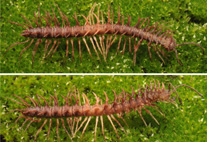Abstract
The genus Alterosa was erected by Blahnik (2005) to include 20 new species, as well as two previously described species, Dolophilodes (Sortosa) sanctipauli Flint 1971 and Dolophilodes (Sortosa) marinonii Almeida & Duarte 2003 that Blahnik transferred into it. Currently the genus contains 38 species, all of them endemic to the Brazilian Atlantic Forest (Jardim & Dumas 2012; Dumas & Nessimian 2013; Dumas et al. 2013). The rapid increase in the number of species reflects a likelihood that much of the total diversity within Alterosa is unknown. Adults are usually encountered in pristine headwaters, rapids of streams, or small rivers, and are rarely collected near large rivers (Dumas et al. 2013). The immature stages are unknown. Although there are superficial similarities among the species within the genus, they can be easily identified by male genital features (Jardim & Dumas 2012). Recently, Dumas et al. (2013) provide an identification key based on characters of male genitalia.

